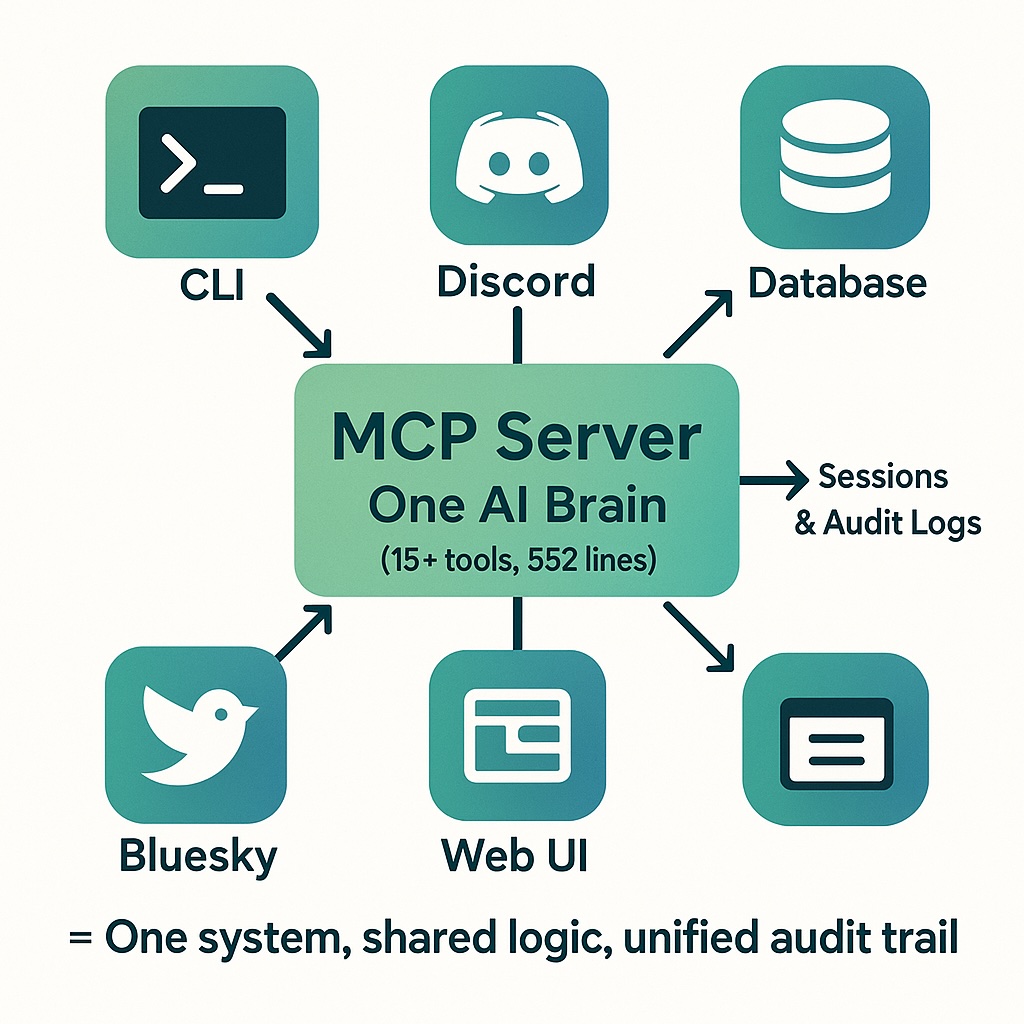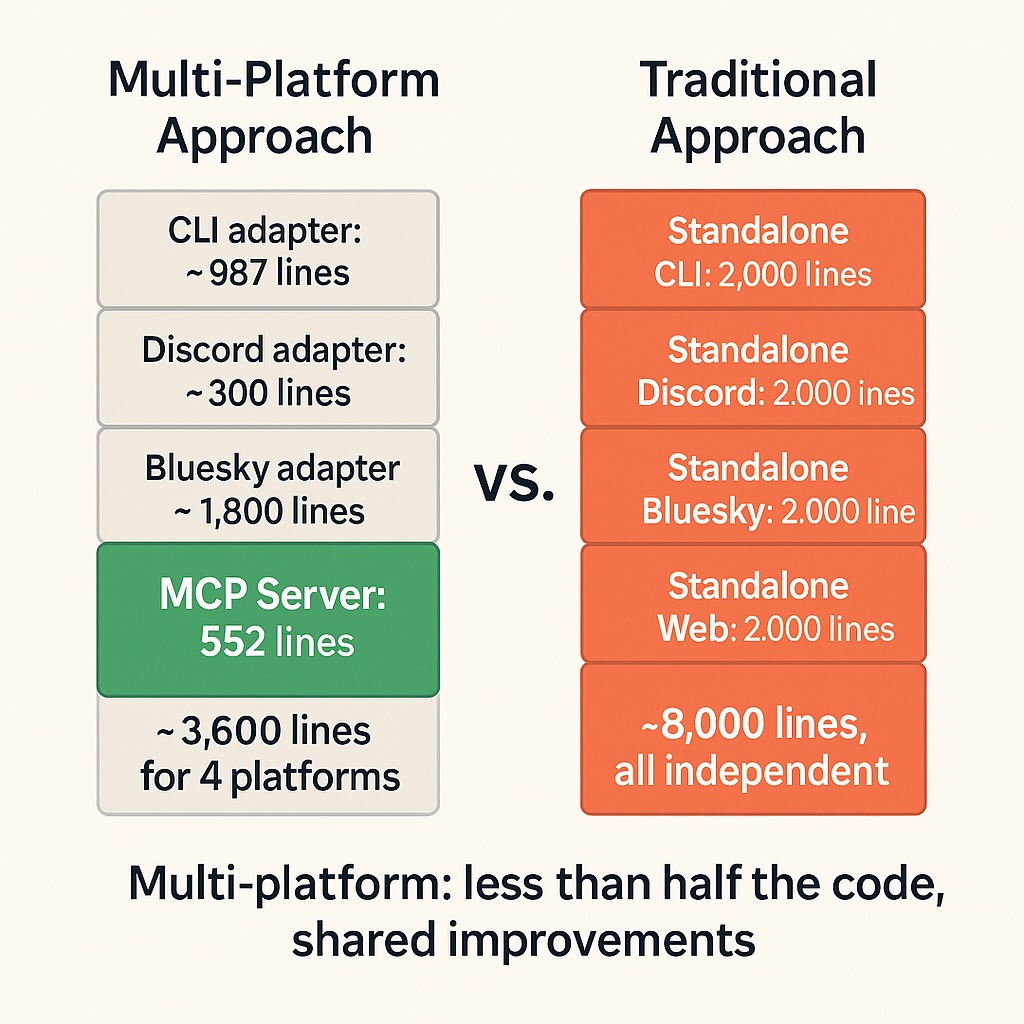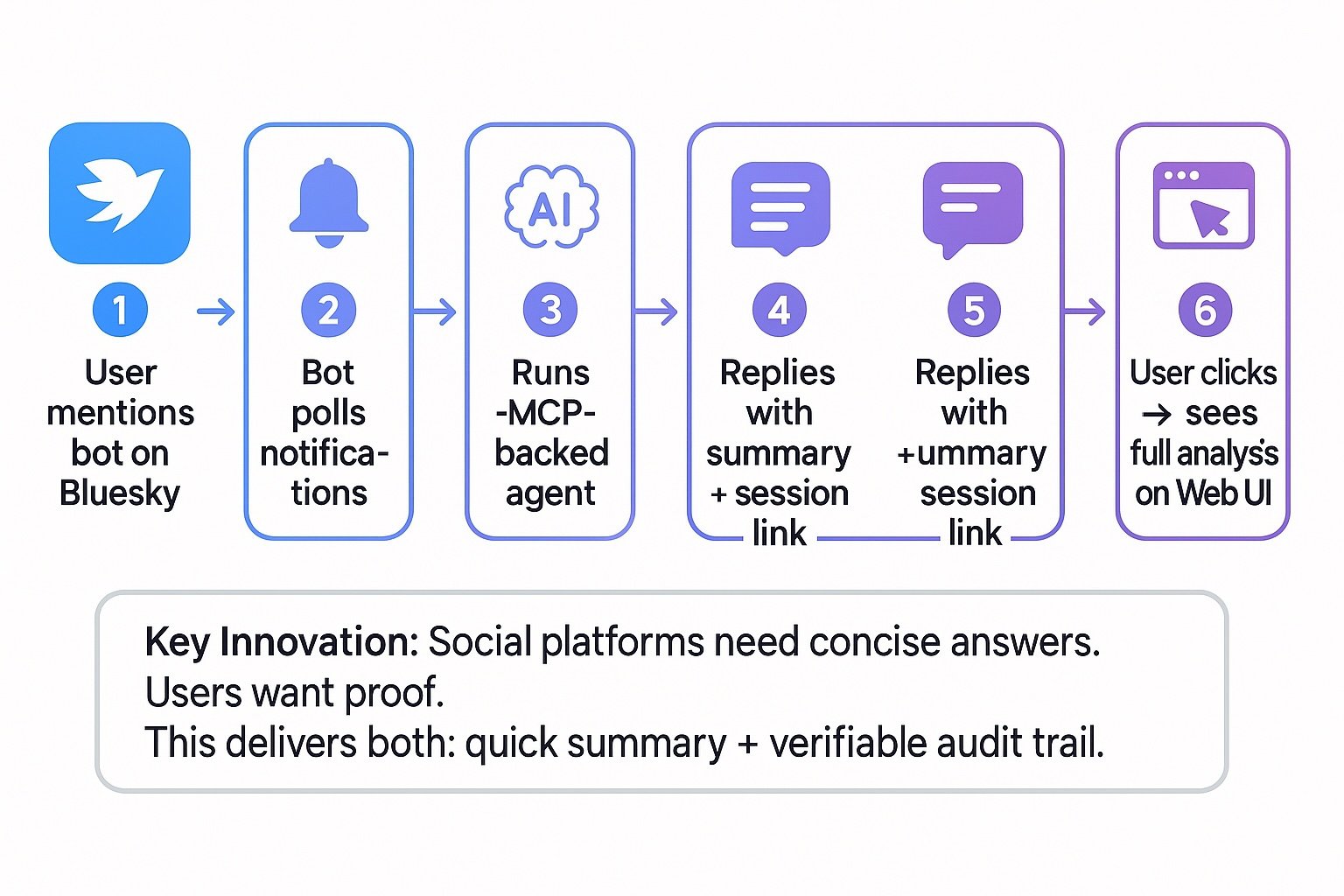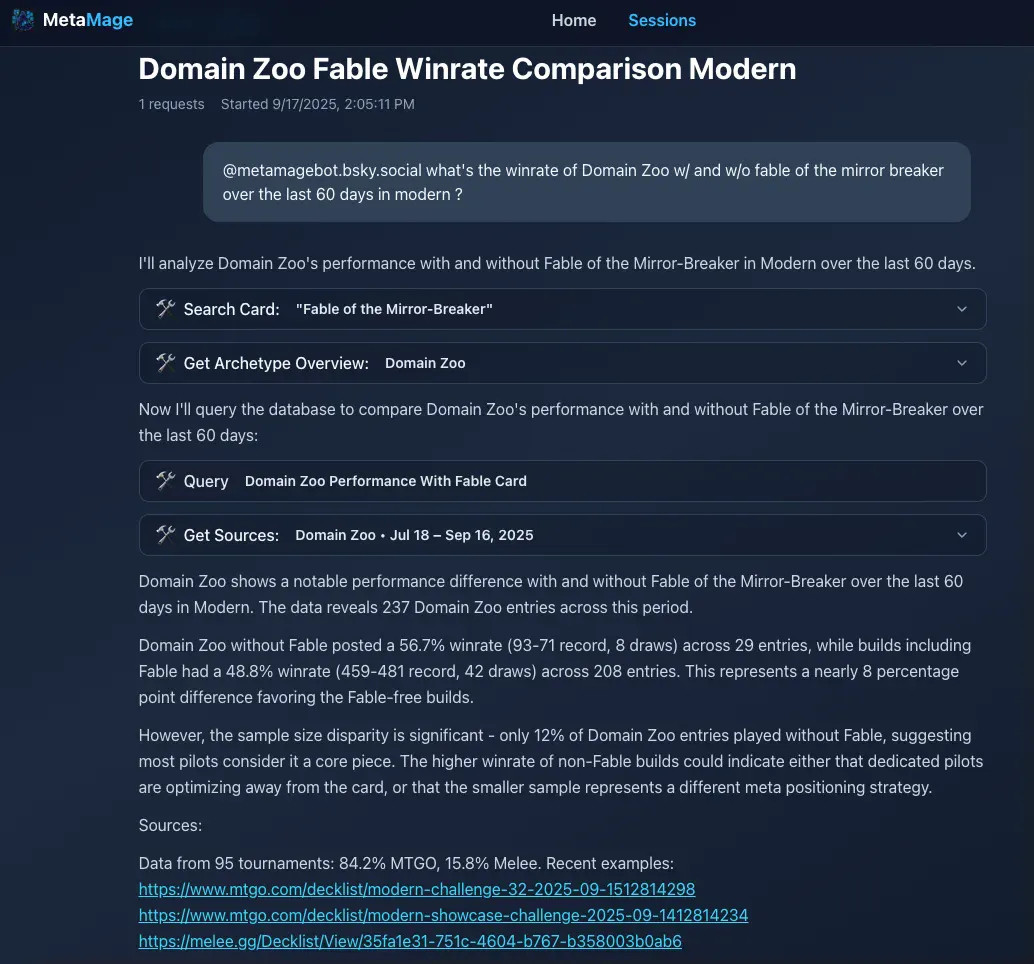At a glance
- One AI brain powers four interfaces: CLI, Discord bot, Bluesky bot, and Web UI
- Add new platforms in ~3 days after initial architecture
- All channels share sessions, audit logs, and improvements
- Production system handling real queries with ~5-second response times
Try the live system → metamages.com
The Business Problem
Your team wants AI on Slack. Your customers DM you on Twitter. Your developers need a CLI. Your board wants a web dashboard.
Most companies build four separate AI solutions. Each needs its own:
- LLM integration and prompt engineering
- Error handling and retry logic
- Session management and logging
- Security and rate limiting
- Deployment and monitoring
That's 4x the development time, 4x the bugs to fix, and 4x the maintenance cost. When your AI improves or your data changes, you update four systems. When a new platform emerges, you start from scratch.

The Solution: One Brain, Many Interfaces
Build your AI logic once as a standalone service. Then connect thin interface adapters for each platform.
The core service (MCP server in this example) contains:
- All your AI tools and capabilities
- Business logic and data access
- Session logging and audit trails
- Security and performance controls
Each interface is just an adapter (~1,000 lines of code):
- Receives requests in platform format (Discord slash command, Bluesky mention, HTTP request)
- Calls the core AI service
- Formats response for that platform

When you improve your AI, all platforms benefit immediately. When you add a new platform, you write one adapter—not a whole new system.
The Catch: When to Use This Pattern
Use this approach when:
- You need AI on multiple channels (3+ platforms)
- Your AI logic is substantial and evolving
- You need unified audit trails for compliance
- Different users prefer different interfaces
Don't use this when:
- You only need one platform (overengineering)
- Each platform needs completely different capabilities
- You're validating a prototype (start simple)
The initial architecture takes more planning than a single-platform bot. But if you're already maintaining 2-3 separate AI systems, you'll break even in weeks.
Real-World Example: MetaMage
MetaMage is a production AI system for tournament data analysis that runs across four platforms.
What It Does
Users ask natural language questions ("What's the conversion rate for our Q3 campaign across email vs. social channels?") and get analysis backed by your data warehouse, with full audit trails showing which tools were used.
In production, MetaMage analyzes tournament data for a gaming community. The same architecture works for retail analytics, financial reporting, customer support analysis—any domain where you need AI across multiple channels.
The Architecture
Core: MCP Server (552 lines)
- 15+ specialized tools (search, analyze, compare)
- Read-only database access with security hardening
- All AI logic, no platform-specific code
Interfaces:
- CLI chat agent: Direct terminal conversation (~987 lines)
- Discord bot: Slash commands in servers (~300 lines adapter)
- Bluesky bot: Responds to social mentions (~1,800 lines including client)
- Web UI: Browse sessions, shareable results (Next.js app)
The Results
Time to add each interface: ~3 days of full-time work after the MCP server was built
Response time: ~5 seconds typical (LLM reasoning time; database queries are near-instant)
Code efficiency:

- Core MCP Server: 552 lines (powers all platforms)
- Per-interface adapters: 300-1,000 lines each
- Total: ~3,600 lines for 4 platforms
Compare to traditional approach: ~2,000 lines per standalone system × 4 = 8,000+ lines, all independent
The multi-platform approach delivers 4 interfaces with less than half the code of 4 separate systems.
The Bluesky Integration (Novel Pattern)
The Bluesky bot demonstrates a pattern worth stealing:

- Bot polls Bluesky notifications for mentions
- Fetches thread context for conversational continuity
- Runs the same MCP-backed agent used by CLI and Discord
- Summarizes the answer to ≤300 characters (Bluesky constraint)
- Replies in-thread with summary + link to full session on Web UI
- Users click through to see complete tool execution and sources
This solves a key problem: social platforms need concise answers, but users want proof. The bot gives both—a quick summary and a link to the full audit trail.
Real example:
A user on Bluesky asks about Domain Zoo's win rate with/without a specific card. The bot:
- Analyzes 237 tournament entries
- Calculates win rates: 56.7% without the card, 48.8% with it
- Summarizes in one paragraph
- Links to full analysis at metamages.com/sessions/3d8...
Users on Discord get the full analysis immediately. Bluesky users get a summary with a link. Same AI brain, formatted for each platform's context.


Why This Matters to You
You're not rebuilding AI logic for each channel. When you fix a bug, improve a prompt, or add a capability, it works everywhere instantly.
You can launch on new platforms in days, not months. Each new interface is just an adapter. The hard work (AI logic, error handling, security) is already done.
Your AI gets smarter once, benefits everyone. Add a new data source or capability to the MCP server, and CLI users, Discord users, Bluesky users, and Web users all get it.
Unified audit trail for compliance. Every query—regardless of platform—logs to the same database. One system to monitor, one system to audit.
Users choose their interface. Developers use the CLI. Community managers use Discord. Social media teams use Bluesky. Executives use the Web UI. They all get the same AI, formatted for their workflow.
The Bottom Line
If you're building AI for multiple platforms, you have two options:
- Build separate systems: 2,000+ lines per platform, independent maintenance, diverging capabilities
- Build one brain with adapters: 500-1,000 lines of core logic, 300-1,000 lines per interface, shared improvements
The second approach costs more up-front. But after your second or third platform, you're saving weeks of engineering time.
And when a new platform emerges (remember when Discord was niche?), you'll be there in days while competitors spend months.
What to Do Next
If you're building AI for multiple channels (or planning to):
→ Let's talk. I'll audit your current setup and show you where you're duplicating work across platforms. No pitch, just a 15-minute breakdown of what you could consolidate.
I built this architecture for tournament analysis (MetaMage). I'm working with traditional enterprises on financial analytics, multi-channel customer support, and internal tools. If you're maintaining 2+ AI systems that do similar things, you're spending money you don't need to.
The best time to unify your AI was before you built the second platform. The second-best time is now.
Live demo → metamages.com | Bluesky bot → @metamagebot.bsky.social

